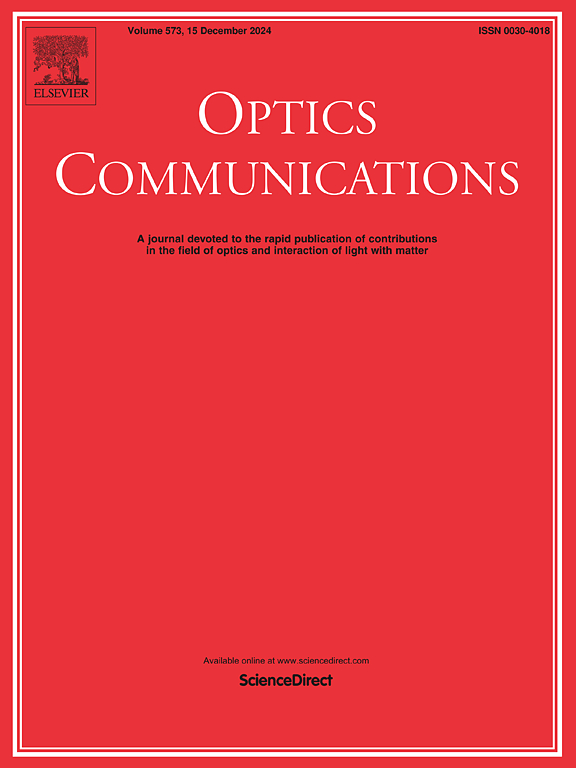Luminescence properties and application of near-infrared Er3+-doped bismuth germanate laser glass
IF 2.5
3区 物理与天体物理
Q2 OPTICS
引用次数: 0
Abstract
Er3+-doped bismuth germanate laser materials were prepared using the conventional high-temperature melt-quenching method. The results of both the DSC and XRD analyses demonstrate that bismuth germanate glasses exhibit optimal thermal stability and a good amorphous phase. In a subsequent analysis, the internal topology of the laser glass was deduced through the integration of Raman spectroscopy. This analysis revealed that the incorporation of H3BO3 and Al2O3 could enhance the thermodynamic properties of the glass. The J-O theory calculations yielded the following parameters: intensity parameter Ω2 = 6.49 × 10−20cm2, quality factor χ = 1.00, spontaneous radiation probability Arad = 449.40 s−1, and fluorescence lifetime τrad = 2.23 ms. The data demonstrate superiority over other glass systems. In order to study the luminescence characteristics of Er3+ in the near-infrared band, the absorption and emission cross sections as well as the gain coefficient curves were calculated based on the absorption and emission spectra. Meanwhile, the microscopic energy transfer coefficient CD-A (1.34 × 10−38 cm6/s) for the CR process between Er3+ was calculated according to Dexter's theory. In addition, the laser glass prepared in this paper was applied in a multi-core photonic crystal fiber, and the inter-core crosstalk XT (−56.8 dB), the effective mode-field area Aeff (363 μm2), and the photovoltaic field strengths were quantitatively computed and analyzed by the beam propagation method (BPM) and the finite element method (FEM). The results show that bismuth germanate glass is an excellent gain medium for realizing high-quality laser emission of Er3+ in the near-infrared band.
近红外掺Er3+锗酸铋激光玻璃的发光特性及应用
采用常规高温熔淬法制备了掺Er3+锗酸铋激光材料。DSC和XRD分析结果表明,锗酸铋玻璃具有最佳的热稳定性和良好的非晶相。在随后的分析中,通过拉曼光谱的积分推导了激光玻璃的内部拓扑结构。分析表明,H3BO3和Al2O3的掺入可以提高玻璃的热力学性能。J-O理论计算得到:强度参数Ω2 = 6.49 × 10−20cm2,质量因子χ = 1.00,自发辐射概率Arad = 449.40 s−1,荧光寿命τrad = 2.23 ms。这些数据表明了其优于其他玻璃系统的优越性。为了研究Er3+在近红外波段的发光特性,根据Er3+的吸收和发射光谱计算了其吸收和发射截面以及增益系数曲线。同时,根据Dexter理论计算了Er3+之间CR过程的微观能量传递系数CD-A (1.34 × 10−38 cm6/s)。此外,将所制备的激光玻璃应用于多芯光子晶体光纤中,采用光束传播法(BPM)和有限元法(FEM)对芯间串扰XT(−56.8 dB)、有效模场面积Aeff (363 μm2)和光伏场强进行了定量计算和分析。结果表明,锗酸铋玻璃是实现Er3+在近红外波段高质量激光发射的优良增益介质。
本文章由计算机程序翻译,如有差异,请以英文原文为准。
求助全文
约1分钟内获得全文
求助全文
来源期刊

Optics Communications
物理-光学
CiteScore
5.10
自引率
8.30%
发文量
681
审稿时长
38 days
期刊介绍:
Optics Communications invites original and timely contributions containing new results in various fields of optics and photonics. The journal considers theoretical and experimental research in areas ranging from the fundamental properties of light to technological applications. Topics covered include classical and quantum optics, optical physics and light-matter interactions, lasers, imaging, guided-wave optics and optical information processing. Manuscripts should offer clear evidence of novelty and significance. Papers concentrating on mathematical and computational issues, with limited connection to optics, are not suitable for publication in the Journal. Similarly, small technical advances, or papers concerned only with engineering applications or issues of materials science fall outside the journal scope.
 求助内容:
求助内容: 应助结果提醒方式:
应助结果提醒方式:


